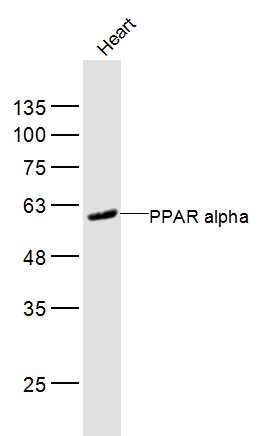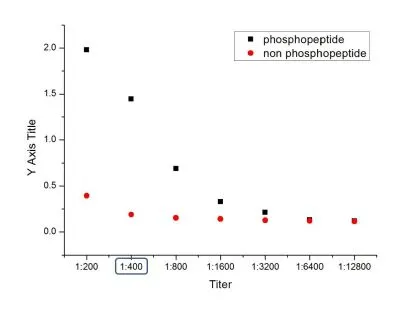PPAR alpha antibody
GTX101098
ApplicationsImmunoPrecipitation, Western Blot, ChIP Chromatin ImmunoPrecipitation, ImmunoHistoChemistry, ImmunoHistoChemistry Paraffin
Product group Antibodies
ReactivityHuman, Insect, Mouse, Plant, Rat
TargetPPARA
Overview
- SupplierGeneTex
- Product NamePPAR alpha antibody
- Delivery Days Customer9
- Application Supplier NoteWB: 1:500-1:3000. IP: 1:100-1:500. *Optimal dilutions/concentrations should be determined by the researcher.Not tested in other applications.
- ApplicationsImmunoPrecipitation, Western Blot, ChIP Chromatin ImmunoPrecipitation, ImmunoHistoChemistry, ImmunoHistoChemistry Paraffin
- CertificationResearch Use Only
- ClonalityPolyclonal
- Concentration1.04 mg/ml
- ConjugateUnconjugated
- Gene ID5465
- Target namePPARA
- Target descriptionperoxisome proliferator activated receptor alpha
- Target synonymsNR1C1, PPAR, PPAR-alpha, PPARalpha, hPPAR, peroxisome proliferator-activated receptor alpha, nuclear receptor subfamily 1 group C member 1, peroxisome proliferative activated receptor, alpha
- HostRabbit
- IsotypeIgG
- Protein IDQ07869
- Protein NamePeroxisome proliferator-activated receptor alpha
- Scientific DescriptionPeroxisome proliferators include hypolipidemic drugs, herbicides, leukotriene antagonists, and plasticizers; this term arises because they induce an increase in the size and number of peroxisomes. Peroxisomes are subcellular organelles found in plants and animals that contain enzymes for respiration and for cholesterol and lipid metabolism. The action of peroxisome proliferators is thought to be mediated via specific receptors, called PPARs, which belong to the steroid hormone receptor superfamily. PPARs affect the expression of target genes involved in cell proliferation, cell differentiation and in immune and inflammation responses. Three closely related subtypes (alpha, beta/delta, and gamma) have been identified. This gene encodes the subtype PPAR-alpha, which is a nuclear transcription factor. Multiple alternatively spliced transcript variants have been described for this gene, although the full-length nature of only two has been determined. [provided by RefSeq]
- ReactivityHuman, Insect, Mouse, Plant, Rat
- Storage Instruction-20°C or -80°C,2°C to 8°C
- UNSPSC12352203
References
- Guo X, Liang K, Xia L, et al. Mof plays distinct roles in hepatic lipid metabolism under healthy or non-alcoholic fatty liver conditions. iScience. 2023,26(12):108446. doi: 10.1016/j.isci.2023.108446Read this paper
- Shou JW, Shaw PC. Berberine Reduces Lipid Accumulation in Obesity via Mediating Transcriptional Function of PPARδ. Int J Mol Sci. 2023,24(14). doi: 10.3390/ijms241411600Read this paper
- Egusa G, Ohno H, Nagano G, et al. Selective activation of PPARα maintains thermogenic capacity of beige adipocytes. iScience. 2023,26(7):107143. doi: 10.1016/j.isci.2023.107143Read this paper
- Saito K, Sekiya M, Kainoh K, et al. Obesity-induced metabolic imbalance allosterically modulates CtBP2 to inhibit PPAR-alpha transcriptional activity. J Biol Chem. 2023,299(7):104890. doi: 10.1016/j.jbc.2023.104890Read this paper
- Toda T, Ito M, Takeda JI, et al. Extremely low-frequency pulses of faint magnetic field induce mitophagy to rejuvenate mitochondria. Commun Biol. 2022,5(1):453. doi: 10.1038/s42003-022-03389-7Read this paper
- Lin CH, Li HY, Wang SH, et al. Consumption of Non-Nutritive Sweetener, Acesulfame Potassium Exacerbates Atherosclerosis through Dysregulation of Lipid Metabolism in ApoE(-/-) Mice. Nutrients. 2021,13(11). doi: 10.3390/nu13113984Read this paper
- Chen HJ, Ko CY, Xu JH, et al. Alleviative Effect of Ruellia tuberosa L. on Insulin Resistance and Abnormal Lipid Accumulation in TNF-α-Treated FL83B Mouse Hepatocytes. Evid Based Complement Alternat Med. 2021,2021:9967910. doi: 10.1155/2021/9967910Read this paper
- Igarashi Y, Iida S, Dai J, et al. Glavonoid-rich oil supplementation reduces stearoyl-coenzyme A desaturase 1 expression and improves systemic metabolism in diabetic, obese KK-A(y) mice. Biomed Pharmacother. 2021,140:111714. doi: 10.1016/j.biopha.2021.111714Read this paper
- Dai J, Li Y, Kametani F, et al. Curcumin promotes AApoAII amyloidosis and peroxisome proliferation in mice by activating the PPARα signaling pathway. Elife. 2021,10. doi: 10.7554/eLife.63538Read this paper
- Wang CY, Chao YJ, Chen YL, et al. Upregulation of peroxisome proliferator-activated receptor-α and the lipid metabolism pathway promotes carcinogenesis of ampullary cancer. Int J Med Sci. 2021,18(1):256-269. doi: 10.7150/ijms.48123Read this paper



![FACS analysis of 3T3 cells using GTX12412 PPAR alpha antibody [3B6/PPAR] compared to an isotype control (blue). Dilution : 0.25 ug/test for 60 min at room temperature Fixation : 2% paraformaldehyde](https://www.genetex.com/upload/website/prouct_img/normal/GTX22779/GTX22779_138_FACS_w_23060620_338.webp)
![WB analysis of 25 ug of Hela (Lane 1), Jurkat (Lane 2), and NIH-3T3 cell lysates (Lane 3) using GTX12412 PPAR alpha antibody [3B6/PPAR]. Dilution : 1:1000 (lane 1 and 2) & 1:500 (lane 3)](https://www.genetex.com/upload/website/prouct_img/normal/GTX12412/GTX12412_1480_WB_w_23060522_816.webp)

